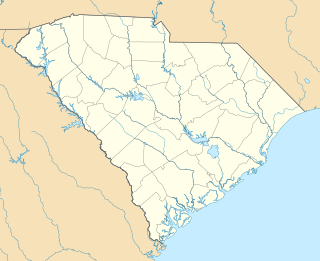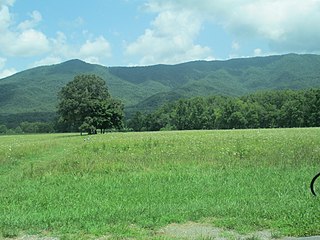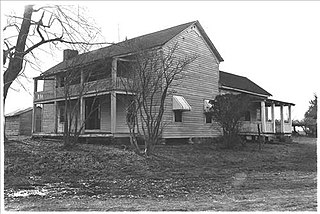
The Appomattox Court House National Historical Park is a preserved 19th-century village in Appomattox County, Virginia. The village is famous for the site of the Battle of Appomattox Court House, and contains the house of Wilmer McLean, where the surrender of the Army of Northern Virginia under Robert E. Lee to Union commander Ulysses S. Grant took place on April 9, 1865, effectively ending the American Civil War. The McLean House was the site of the surrender conference, but the village itself is named for the presence nearby of what is now preserved as the Old Appomattox Court House.

The Cherokee Path was the primary route of English and Scots traders from Charleston to Columbia, South Carolina in Colonial America. It was the way they reached Cherokee towns and territories along the upper Keowee River and its tributaries. In its lower section it was known as the Savannah River. They referred to these towns along the Keowee and Tugaloo rivers as the Lower Towns, in contrast to the Middle Towns in Western North Carolina and the Overhill Towns in present-day southeastern Tennessee west of the Appalachian Mountains.

New Echota was the capital of the Cherokee Nation in the Southeast United States from 1825 to their forced removal in the late 1830s. New Echota is located in present-day Gordon County, in northwest Georgia, 3.68 miles north of Calhoun. It is south of Resaca, next to present day New Town, known to the Cherokee as Ustanali. The site has been preserved as a state park and a historic site. It was designated in 1973 as a National Historic Landmark District.

Cades Cove is an isolated valley located in the Tennessee section of the Great Smoky Mountains National Park, USA. The valley was home to numerous settlers before the formation of the national park. Today Cades Cove, the single most popular destination for visitors to the park, attracts more than two million visitors a year because of its well preserved homesteads, scenic mountain views, and abundant display of wildlife. The Cades Cove Historic District is listed on the National Register of Historic Places.

The Hunter's Home, formerly known as the George M. Murrell Home, is a historic house museum at 19479 E Murrel Rd in Park Hill, near Tahlequah, Oklahoma in the Cherokee Nation. Built in 1845, it is one of the few buildings to survive in Cherokee lands from the antebellum period between the Trail of Tears relocation of the Cherokee people and the American Civil War. It was a major social center of the elite among the Cherokee in the mid-nineteenth century. It has been owned by the state since 1948, and was designated a National Historic Landmark in 1974.

Nikwasi comes from the Cherokee word for "star", Noquisi (No-kwee-shee), and is the site of the Cherokee town which is first found in colonial records in the early 18th century, but is much older. The town covered about 100 acres on the floodplain of the Little Tennessee River. Franklin, North Carolina, was later developed by European Americans around this site.

Table Rock State Park is a 3,083-acre (12.48 km2) park at the edge of the Blue Ridge Mountains in northern Pickens County, South Carolina. The park includes Pinnacle Mountain, the tallest mountain totally within the state.

Red Clay State Historic Park is a state park located in southern Bradley County, Tennessee, United States. The park was the site of the last capital of the Cherokee Nation in the eastern United States from 1832 to 1838 before the enforcement of the Indian Removal Act of 1830. This resulted in a forced migration of most of the Cherokee people to present-day Oklahoma known as the Cherokee removal. The site is considered sacred to the Cherokees, and includes the Blue Hole Spring, a large hydrological spring. It is also listed as an interpretive center along the Trail of Tears National Historic Trail.

Oconaluftee Archeological District is within the eponymous river valley in the Great Smoky Mountains of North Carolina, located in the Southeastern United States. Formerly a historic Cherokee village, followed by an Appalachian community, were located at this site along the Oconaluftee River. Now the site serves as the main entrance to the North Carolina side of the Great Smoky Mountains National Park.

Sequoyah's Cabin is a log cabin and historic site off Oklahoma State Highway 101 near Akins, Oklahoma. It was the home between 1829 and 1844 of the Cherokee Indian Sequoyah, who in 1821 created a written language for the Cherokee Nation. The cabin and surrounding park, now owned by the Cherokee Nation, was declared a National Historic Landmark in 1965.

Hickory Hill, also known sometimes as the Thomas E. Watson House, is a historic house museum at 502 Hickory Hill Drive in Thomson, Georgia. A National Historic Landmark, it was a home of Georgia Populist Party co-founder Thomas E. Watson (1856-1922). The main house was added to the National Register of Historic Places (NRHP) in 1976 (#76002144) and the whole site was added to the NRHP in 1979 (.

Paris Mountain State Park is a state park in the U.S. state of South Carolina, located five miles (8 km) north of Greenville. Activities available in the 1,540-acre (6 km2) park include hiking, biking, swimming and picnicking. The 13-acre (52,609 m2) Lake Placid offers swimming and fishing. Canoes, kayaks, and pedal boats are seasonally available for rental; private boats are not permitted. Camping is allowed and campsites range from rustic, back country sites to paved sites with water and electricity hook-ups. The park's Civilian Conservation Corps (CCC) structures, including the Camp Buckhorn lodge, are listed on the National Register of Historic Places. m.

The Carson House is a historic house and museum located in Marion, North Carolina. It was the home of Col. John Carson, and served as the McDowell County courthouse when the county was first organized in 1842.

The Noah "Bud" Ogle Place was a homestead located in the Great Smoky Mountains of Sevier County, in the U.S. state of Tennessee. The homestead presently consists of a cabin, barn, and tub mill built by mountain farmer Noah "Bud" Ogle (1863–1913) in the late 19th century. In 1977, the homestead was added to the National Register of Historic Places and is currently maintained by the Great Smoky Mountains National Park.

The John Covington Moore House is a historic house in rural Clay County, North Carolina. It is located on North Carolina Route 1307, about 4 miles (6.4 km) from the county seat, Hayesville. The 1-1/2 story log structure was built c. 1838 by John C. Moore, not long after the forced removal of the Cherokee from the area. The building is mounted on fieldstone piers, and has a porch extending across its front. There are shed-roofed rooms across the back of the house, and an exterior chimney at one end.

Walker's Inn is a historic building in rural Cherokee County, North Carolina. It is located at the northeast corner of the junction of SR 1505 and SR 1383 near Andrews. The house, appearing as a two-story five-bay frame house, was apparently built in stages, beginning c. 1844, after William Walker acquired the land on which it stands. The three rightmost bays of the house are a log structure, while the two on the left are a frame structure. The logs are partially exposed on the front, while most of the house is sheathed in board-and-batten siding. Windows are irregularly placed on the main facade. Long known as an inn, it sits along what was in the 19th century the major route between Franklin and Murphy. Frederick Law Olmsted stayed at the inn during his travels in the area in the late 19th century.

The Hall Cabin, also known as the J. H. Kress Cabin is a historic log cabin in Great Smoky Mountains National Park, about 15 miles (24 km) from Fontana, North Carolina. The cabin is a rectangular split-log structure 24 feet (7.3 m) wide and 17 feet (5.2 m) deep, with a porch spanning its front. The gable ends of the roof are sheathed in board-and-batten siding. It was built by a man named Hall in 1910, and underwent some remodeling around 1940 when J. H. Kress used it as a hunting lodge. It is located in the drainage of Hazel Creek, an area which historically had a small population and was abandoned after the construction of Fontana Lake and the national park. It is the only structure remaining in its immediate vicinity.

The Kemp-Shepard House is a historic house on Highbridge Road in Georgia, Vermont. The main block of the brick house, built about 1830, is an important early work of a regional master builder, and it is attached to an older wood-frame ell. It was built on land that was among the first to be settled in the eastern part of the town. The house was listed on the National Register of Historic Places in 1997.

The Bowman-Pirkle House is a historic two-story log house in Buford, Georgia.

The Judge Franklin Faulkner House, on E. Cherokee St. in Sallisaw, Oklahoma, was built around 1845. It was listed on the National Register of Historic Places in 1980.
























